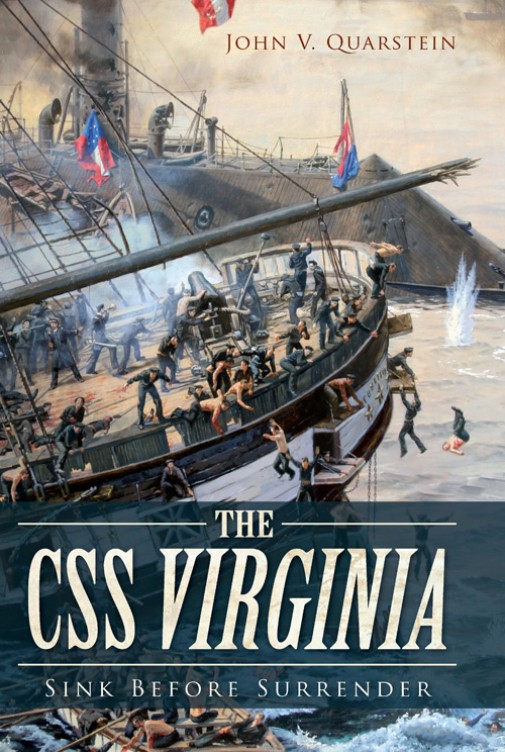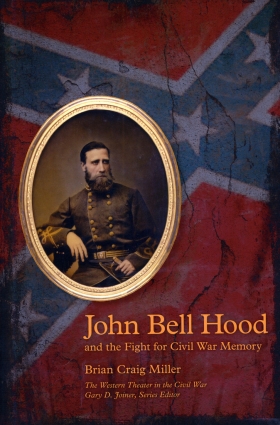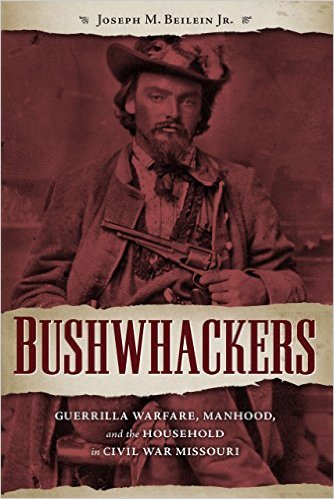As one of the main participants in the Battle of Hampton Roads, the CSS Virginia has received considerable attention from historians. But these works tend to focus on the ship’s novel construction, introducing iron armor and steam propulsion, and on the naval battle itself. With The CSS Virginia, Quarstein offers a naval equivalent to the landlubber’s regimental histories. Not only does he trace the design, construction, and service of the Confederate ironclad, but he also brings forth the personal stories of the crew, bonding these elements into a complete narrative.
Quarstein begins the Virginia’s story discussing the ship’s origins as the USS Merrimack. The frigate featured many experimental components, all of which Quarstein covers in detail that pleases technically-minded readers. While discussing the Merrimack’s maiden voyage, Querstein introduces Catesby ap Roger Jones, a Lieutenant sent to observe the ship’s trials. The Merrimack herself was a failure – an underpowered, deep-drafted, unstable gun platform – all rather ironic considering later events. That failure placed the ship at the Gosport Navy Yard awaiting an overhaul on the eve of the Civil War. The Federals burned the Merrimack to the water line when abandoning the yard in April 1861.
This turn of events enabled the Confederates to turn an otherwise failed design into a revolutionary warship. Quarstein documents, rather completely, the design and modification that transformed Merrimack into Virginia. Quarstein also covers material shortages and logistical challenges which hindered the conversion. Again we meet Jones as he becomes involved testing the ironclad’s armor and is later named executive officer of the ship.
Jones’ duties outfitting the ship included assembly of the crew. And here Quarstein provides introductions to the sailors who would bring the ironclad into battle – both the officers and the men. While the crew included seasoned sailors, some men came from the ranks of infantry units – both volunteers and impressed – to fill out the ship’s roster. Quarstein explains the roundabout way Confederate Secretary of the Navy Stephen Mallory effected the appointment of Captain Franklin Buchanan to command the Virginia.
The Virginia started her fateful “shakedown cruise” at 11 a.m. on March 8, 1862, towards Hampton Roads. Quarstein provides firsthand accounts from both sides as he sets the stage for battle. Buchanan focused upon the USS Cumberland as his first target, due to reports that the ship’s rifled guns had the best chance of defeating the Virginia’s armor. Quarstein’s account of the action steps practically broadside-by-broadside through the engagement, highlighting activities on both ships. While the Virginia continued its rampage until 5 p.m., destroying the USS Congress and damaging other warships, tides and daylight worked against extended action.
Quarstein’s account of the next day’s battle continues his detailed treatment of the action. With Jones temporarily replacing the wounded Buchanan, the Virginia maneuvered back into Hampton Roads to engage the newly arrived USS Monitor. Commanders of both vessels opted to break off the inconclusive engagement, claiming the other side was in retreat. Quarstein delivers a balanced answer to the age old question regarding any victory laurels due from the historic engagement, letting the participants express their own views.
Most historians leave the Virginia at the end of Hampton Roads with a footnote concerning her loss two months later. Quarstein instead devotes space to ongoing operations of the ironclad and attempts to re-engage the Federal fleet. Although the Virginia was never to engage in another open battle, her presence served to deter Federal plans, causing a shift in operations on the Peninsula. With the loss of her Norfolk base, and the Virginia unable to pass upriver to Richmond, the crew scuttled the ship on May 11. The crew would later find some redemption, as Quarstein puts it, working in the Confederate defenses that stopped Federal ironclads at Drewry’s Bluff days later.
Quarstein concludes the history of the Virginia with a chapter discussing the ship’s impact on history. From a purely naval standpoint, the first Confederate ironclad provided the template further refined as “casemate” ironclads. Although separated from their ship, many of the Virginia’s crew continued to serve throughout the war. Buchanan famously commanded the CSS Tennessee at Mobile Bay in August 1864. John Taylor Wood captained a successful commerce raider. Jones, however, spent the last years of the war in charge of a naval ordnance factory.
The CSS Virginia includes thirteen appendices, doubling the page count. With these, Quarstein provides biographies of the ship’s designers, officers, and crew. Many readers will be surprised to see fifty-four Confederate marines served on the Virginia at Hampton Roads, or that twenty Virginia veterans surrendered at Appomattox – trivia perhaps, but all speaking to the story of the men who worked the ship. For those interested in the technical and operational details, Quarstein provides detailed statistics of the Virginia along with a lengthy chronology of her service. Also included is an appendix addressing the question of the ship’s name – Merrimack or Virginia?
In researching his topic, Quarstein left few, if any, stones unturned, attesting to the exhaustive bibliography of primary and secondary sources. Quarstein consulted service records, pension applications, and numerous archival sources used to build the crew listings. The book is well illustrated with many from the extensive holdings of the Mariner’s Museum in Newport News, Virginia.
This most complete study of the CSS Virginia is a welcome addition to any bookshelf and complements a similar work done by the author on the USS Monitor.
Craig Swain is a consultant from Virginia but is a native Missourian. His background includes a degree in history and service in the Army. Craig’s focus is the study of Civil War Artillery, which you can read about on his blog—To the Sound of the Guns.





